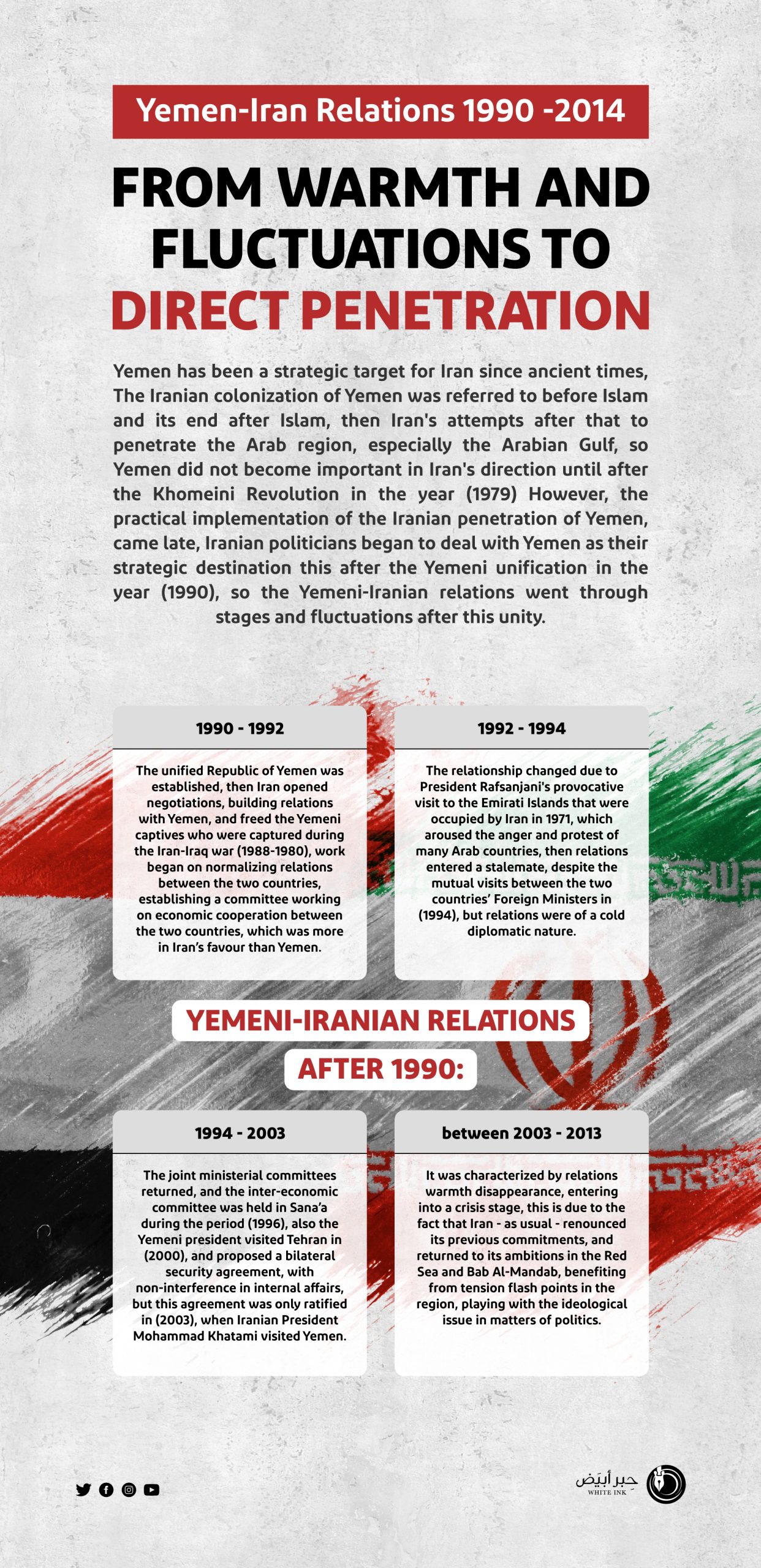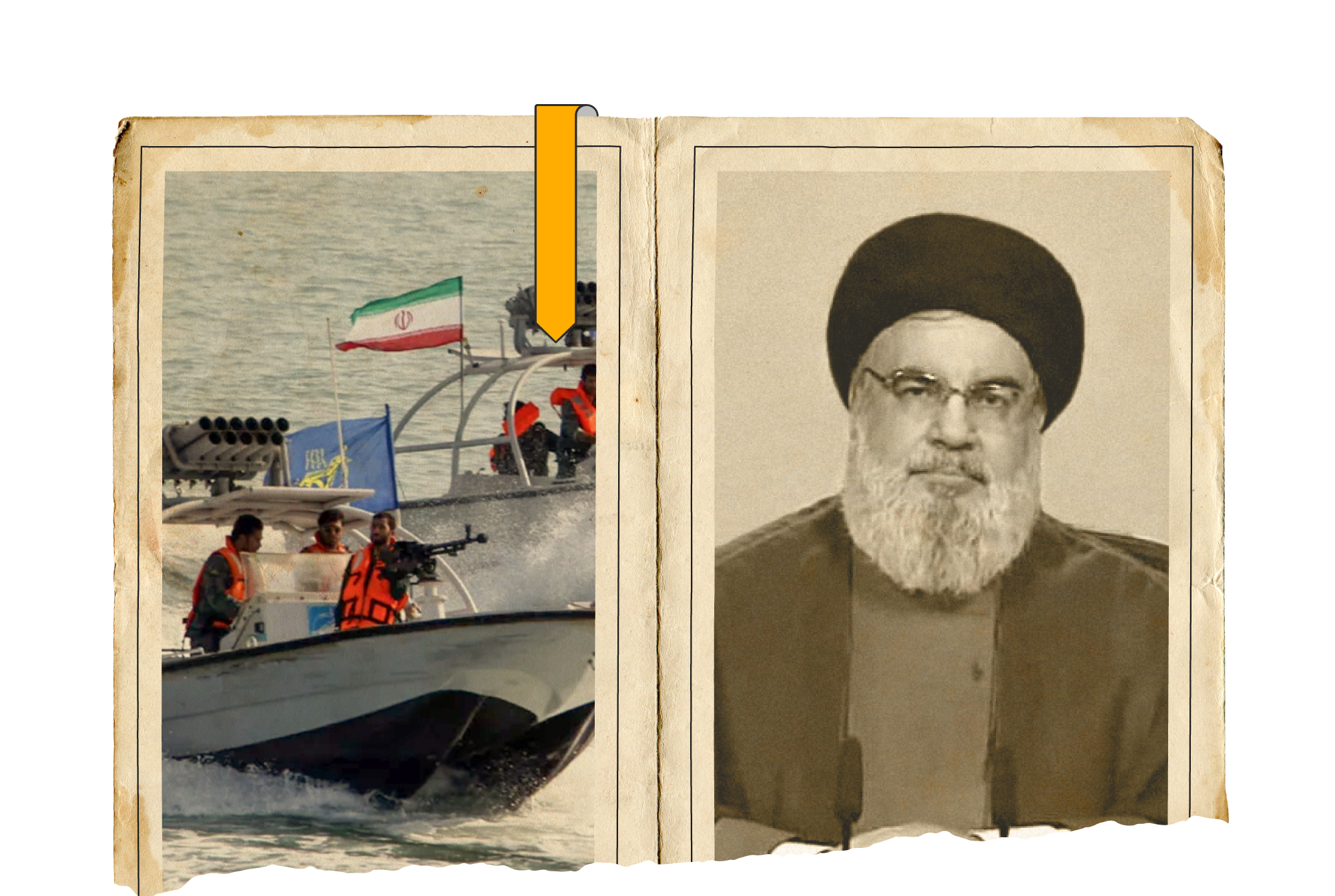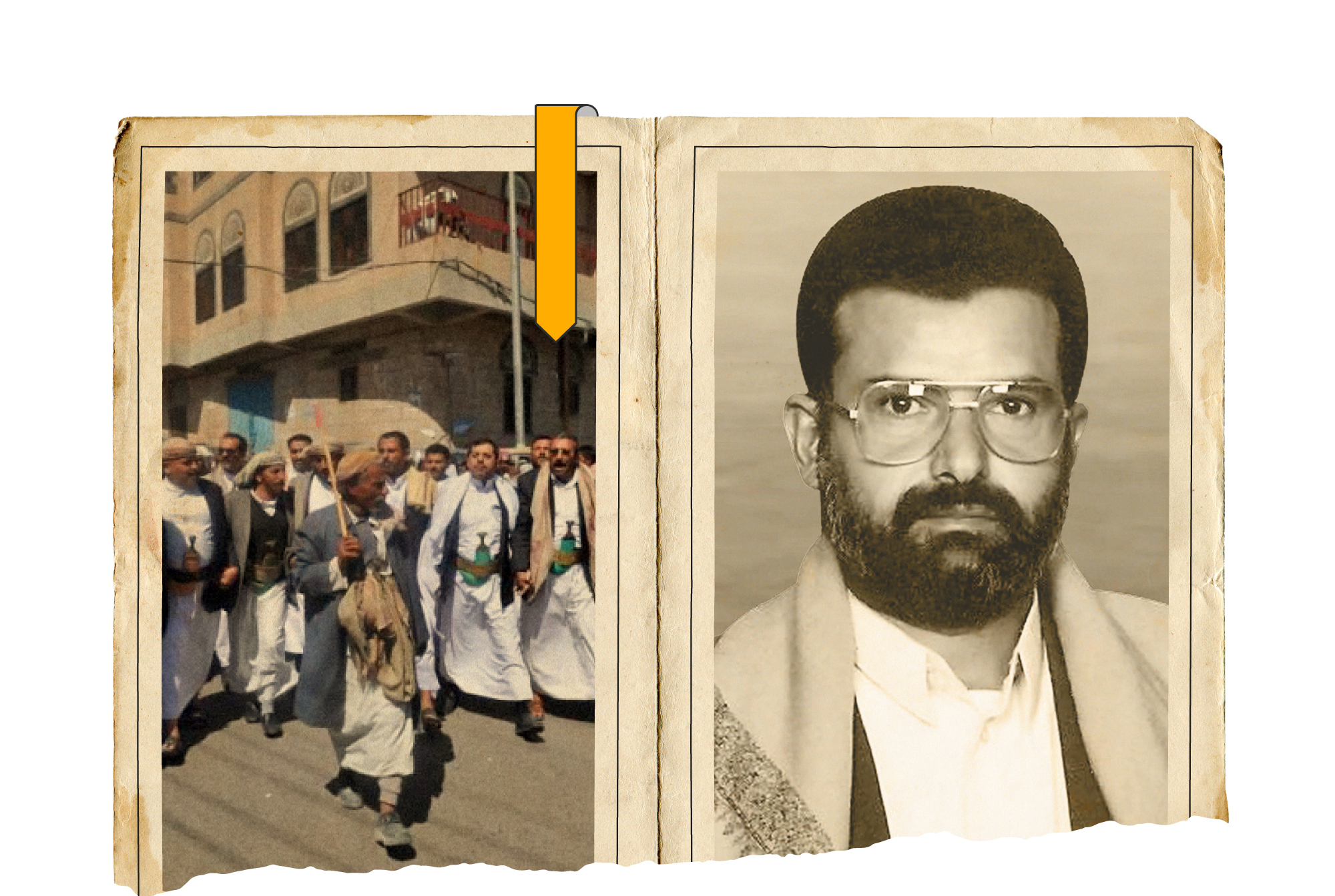
Iranian-Yemeni relations
From reconciliation to deception and direct clash
Yemen has always been the Persian expansionist ambitions focus since ancient times, and its traditional way of trying to penetrate the Arabian Island, which the Persians throughout their history have not been able to penetrate or control, and this matter can be seen through what some have put forward about the “historical tendency” of Persia to the west to control the eastern Mediterranean, the Red Sea and the Bab al-Mandab Strait, also in the framework of the struggle to tighten control over international trade routes.
In the modern era, some define the Iranian strategy towards the Arab region in general, and the Arabian Gulf region and Yemen in particular, as follows: “Iranian politicians have been looking for tension flash points to intervene to control location and wealth, arguing that they are the saviors or rescuers… Iranian politicians have inherited a feeling that there is a strategic-ideological vacuum that must be filled.
What concerns us here is to address the Iranian role in Yemen by monitoring and tracking Iranian-Yemeni relations, especially since the Republic of Yemen founding declaration in (1990), furthermore here we must go back a little to the Iran-Iraq war period, this war that broke out in (1980) and continued until (1988); North Yemen supported Iraq in that war, stood with it from an Arab perspective, and on the basis that Iraq is the eastern gate to the Arab region, it must be protected, so, Yemeni situation greatly angered Tehran.
However, after the Yemeni unity success between north and south, and the Republic of Yemen establishment declaration, Tehran started a new page with Sanaa, by trying to forget the previous pro-Iraq situation in the war, also some believe that this new phase extended from the year (1990) to (1992), the most important features of this stage were represented in ending the Yemeni prisoners file detained by Iran as a result of the Iran-Iraq war, also work began to further normalize relations between the two countries, through of an inter-ministerial committee formation working on economic cooperation between the two countries which was, in fact, more in Iran’s favor than Yemen, and delegations visits were exchanged between Tehran and Yemen, these delegations carried exchanged messages between Iranian President Hashemi Rafsanjani and Yemeni President Ali Abdullah Saleh, furthermore these relations were based during this period on the two principles of reconciliation and common interest.
This policy soon changed in the following period, that is, from the year (1992) until (1994), this change is due to the sudden, strange and provocative visit that President Rafsanjani made to the Emirati islands that were occupied by Iran in the year (1971), the real goal behind this visit was to confirm the islands occupation to Iran, added to this to make these islands more Persianization, which aroused the ire of many Arab countries and their protest against that matter, of course Yemen was at the forefront of these countries, as a result, the inter-ministerial committee work between Iran and Yemen stopped, then the Iranian-Yemeni relations entered into a state of stalemate, although there were mutual visits by the foreign ministers of both countries in 1994, but these visits were of a cold diplomatic nature and did not help restore warming in relations between the two countries.
As for the next stage, it extended from (1996) to the year (2003), began with the inter-ministerial committees return, through the enter-economic committee holding its work in Sana’a during the period from 16 to 18 January (1996), add to this the Yemeni President Ali Abdullah Saleh visited Tehran in the year (2000) a bilateral security agreement was proposed between the two countries, with a stipulation of non-interference in internal affairs, this agreement was only ratified in 2003, when Iranian President Mohammad Khatami visited Yemen, this period was characterized by Khatami’s moderate policy and Iran’s foreign policy in general. However, this stage has not been cleared from Yemen’s criticism of Iran’s policies towards the occupied Emirati Islands.
As for the next stage in Iranian-Yemeni relations, it begins in (2004), extending to (2013), which was characterized by relations warmth disappearance, entering into a stage of crisis, this is due to the fact that Iran – as usual – renounced its previous pledges not to interfere in the internal affairs of Yemen, returned to its old fixed policy and its ambitions in the Red Sea and Bab Al-Mandab, benefiting from tension flash points in the region, playing with the ideological issue in matters of politics.
Radwan Al-Sayyed confirmed a major change occurrence in Iranian politics during this period, with what they called “neo-conservatives” came into power in Iran, just as the neo-conservatives came into power in America, from here Iran resorted to awakening sleeping cells and others supporting them in the Arab world.
This was reflected in the great support provided by Iran to the Houthi group in Yemen, a group that originally belongs to the Zaydi sect spread in northern Yemen, but Iran was able to take this group’s leaders into the Twelver Iranian Sect, by greeting them in Qom, Iran, arguing that this was for religious education.
The Houthi movement was established in (1986) in Saada, then Yemen gradually entered into a sharp dispute with the republican regime in Sana’a; The Houthi movement viewed this regime as the result of the “coup” that took place in the sixties against the “Imam’s Rule” system that it was necessary to return to the Imam’s Rule again. Thus, the Houthis’ vision of “Imam’s Rule” necessity accorded with the theory of “Wilayat al-Faqih” Rule by the Islamic Jurist upon which the Iranian regime is based.
The Houthi movement entered into many wars against the republican regime in Sana’a in the period from (2004) to (2010), furthermore most of the sources are almost unanimous that had it not been for the Iranian material and military support for the Houthi group throughout this period, this group would not have been able to stand up to the Yemeni army, However Tehran has consistently denied direct support to Houthi in its war against Sana’a, this was reflected in the Iranian-Yemeni relations nature during this period, also Iran was not satisfied with its support for the Houthi movement in northern Yemen, but went to try to confirm its presence in southern Yemen, by trying to establish relations with one of the Southern Movement factions, this is Ali Salem Al-Beidh, who resides in Beirut, in constant contact with Hezbollah who played an important role in transferring some Yemeni youth to Tehran for military training.
Thus, Yemeni-Iranian relations reached to the estrangement point, especially after Tehran’s direct support for the Houthi attack on Sana’a in (2014), seizing it, and Iran continues its support for the Houthi regime in Sana’a, persists in not recognizing the Yemeni government that represents legitimacy, add to this Iran takes an unprecedented step in the international relations field; As Tehran accepts credentials from a Houthi leaders as Yemen’s ambassador to Iran, this provoked the protest of the legitimate Yemeni government, accusing Iran of violating international law, because the United Nations resolutions do not recognize the Houthi occupation of Sanaa, but rather recognize the legitimate Yemeni government as the sole representative of the Yemeni people. Thus, Iran was the only country that recognized the usurped Houthi regime, so the Yemeni-Iranian relations reached to the direct confrontation stage.
Iran is the only country that recognizes the Houthi regime in Yemen.



- Jamal Wakim, Eurasia, West and Hegemony over the Middle East (Beirut: Dar Abaad, 2016).
- Jihad Ahmed, Yemeni-Iranian Relations and its Impact on Arabian Gulf Security, East Future for Studies and Research, February 7 (2014).
- Hazem Al-Janabi, “The Iranian Strategy Towards the Arab Countries” Al-Manara Magazine (Academia Arabia), vol18, p2(2012).
- Khaled Al-Qasimi, The Three Islands between Arab Sovereignty and Iranian Occupation (Alexandria: Dar Al-Kutub and Arab Studies, 1997).
- Radwan al-Sayyid, Arabs and Iranians: Arab-Iranian Relations in the Present Time (Beirut: Arab House,2014).
- Dina Abdo, General Trends of Iran’s Regional Interests in the Arab Region, Syria and Yemen 2011-2016 – A Comparative Study, Arab Democratic Center.
- Samuel Ramani, Iranian Post-Conflict Vision in Yemen, Carnegie Foundation, December 11 (2019).


Iranian penetration of Yemen:
Straits Control Strategy: Hormuz-Bab Al-Mandeb
Iran’s penetration of Yemen was the last Persian penetration station in the Arab region (at the current stage), and one of the Iranian strategic goals that were set to place the Arab region between the jaws of the Iranian pincers, especially Yemen’s subjugation enables Mullahs to control the vital Bab al-Mandab Strait after they put their hands on the strategic Hormuz Strait.
Yemen has been a source of political, economic and sectarian attraction for the Mullahs, given its pivotal role in maritime navigation and Tehran’s political role projections without ignoring the sectarian dimension linked to the Twelve Zaydi junctions, also the “Sufyan revolution” that Ali al-Kurani al-Amili promoted in his book (Appearance Age) and its content talks about a revolution that will take place in Yemen, describing it as “the most pertinent flags in the reappearance age at all”… that its capital is Sana’a.
Yemen was a source of political, economic, and sectarian attraction for the Mullahs.

And if the Iranian ambitions are in its real a political-ethnic ambitions, then they have been encapsulated in a religious cover so that they are accepted by those who ignore the reality of the inner Persian goals. Here we find one of Iran’s tweezers in the region – Hassan Nasrallah – confirming this claim by saying: “What Iran is doing in our region is fulfilling its divine duty, these such doing are in harmony with its doctrine and religion.
Religious whims met with historical ambitions and strategic goals to make Yemen a constant target in Iranian foreign policy, especially this region had previously been subject to Persian occupation before Islam’s success in liberating this Arab country from the Persian grip, furthermore, it is clear that Iranian maneuvers are no longer restrained to the backstage and secret communications but the demands for the subjugation of Yemen became “public” and direct, which is what made Yemeni President Abd Rabbo Mansour accuse Iran, in October (2012), of seeking to control the strategic Bab al-Mandab Strait, and international community called to stop what he described as “imminent Iranian plans”.
The complex and “obsessed“ regional environment makes the Iranian presence in Yemen a real threat to the Arab Gulf, Perhaps these threats led the Arab Gulf states to pursue, monitor and stop Iran’s increasing penetration in Yemen, which took many forms, including: Intelligence activity, many Iranians in Yemen work to serve their political interests through modest medical centers, opening the door to commercial facilities for Yemeni figures sympathetic to Tehran, as well as supporting the terrorist rebel Houthi movement in northern Yemen added to this, opening up to the Brotherhood component that agreed with the Iranian thesis since the 1930s.
It can be said that the repeated infiltration operations have caused complications in the Yemeni political scene, and have created conflicting ideological tendencies, some of which have taken a socialist dimension, while others claim to represent the Sunni component in Yemen, added to this the Zaydi component, a large part of which has affiliated with the Iranian project in the region, which threatens to break-up the unified Yemen and converted into sectarian states, especially this fate can be accepted by the Brotherhood organization in Yemen, as well as the Houthi organization, in addition to the political trend that is active in the south.
Perhaps what worries the matter is the security, political, and even humanitarian repercussions of the Yemeni crisis on the rest of the Arab Gulf countries, which may take various forms, including:
- The security and military threat to the region, accompanying with cost and military effort.
- Planting sleeping Iranian cells in the region, starting from Yemen, moving with a kind of ease in light of the neighboring countries’ consideration of the humanitarian situation in Yemen.
- Tens of thousands of Yemenis could be displaced to Gulf border.
- The possibility of terrorist cells forming on Yemen’s security-fragile border areas, whose objectives are in line with Iran in an attempt to strike the region.
Coping Strategy:
The complex security environment in Yemen needs to consider reformulating a strategic drawing that corresponds to security and military compulsions. Here, we see the need to identify the opponent’s strengths and weaknesses to target the enemy’s centers of gravity, which can be summed up in four main goals: to strike the centers of gravity of the hostile military penetration which has a loyal to an external powers; Supporting the Al-Ahwaz region independence to build a strategic shield wall, depriving Iran from the most important sources of financing to the military effort, also working on the media front, by raising Iranian people awareness of internal exhausting caused by Persian expansionist policies in the region, also rethinking to win new regional alliances that considering Iran is “currently” the most dangerous threat to the national security of Arab countries in general, and the Arab Gulf states in particular.


- Jamal Wakim, Eurasia, the West, and Hegemony over the Middle East (Beirut: Dar Abaad, 2016).
- Jihad Abdul Rahman Ahmed, “Yemeni-Iranian Relations and Its Impact on Arabian Gulf Security” an article published on the website of the East Future Center for Studies and Research.
- Radwan Al-Sayed, Arabs and Iranians: Arab-Iranian Relations in the Present Time (Beirut: Arab House for Science Publishers, 2014).
- Samuel Ramani, Iranian Post-Conflict Vision in Yemen, Carnegie Foundation, December 11 (2019).
- Carl von Clausewitz, On War, translated by: Salim El Emami (Beirut: The Arab Foundation, 1997).

Iran penetrated some Arab countries by soft power
With a careful and deep historical look, the reader realizes that the beginning of communication between Yemen and Persia was since the first Abyssinian occupation of Yemen in the year (335 AD), and the second one in the year (525 AD), as it was one of the Persians’ contact with Yemen, when the political communication between Yemen and Persia was through the Yemeni king (Saif bin Dhi Yazan Al-Himyari) sought the Persian emperor’s help to expel the Abyssinians from his country, also communication increased after the advent of Islam when the Islamic doctrine abolished distances and borders, generating mutual communication, exchange, and cooperation between the two sides (at that time).
In modern times, the historical factor is one of the factors of foreign policy formulation, developing a country’s political behavior towards another country or a particular neighboring region; In the Iranian-Persian case, it is no exaggeration to say that history has the strongest effect. If that history is not solely responsible for the nature of Iran’s conduct towards its Arab Neighboring States in particular, and the rest of the Arab States in general, it is clear today that the historical memory of Iranian decision makers and politicians is behind Iranian behavior seeking control of the Arab region. That is why they refuse to accept the fact that the Arab Neighbor is equivalent to them in the region. Furthermore, the Iranian politicians still have a sense of preference and make them do their best to export their revolution to the region countries. After the Iranian Revolution success in (1979), Khomeini formed the Republic’s regime on the principle of “ Al-Wali Al-Faqih” Ruler by the Islamic Jurist; Some of revolution leaders, headed by Al-Wali Al-Faqih, believed that the Iranian model could be applied successfully in the entire region, that the responsibility of transferring this revolution to the rest of the region countries lies with Iran, which is known as the principle of “exporting the revolution.” Which was the result of that public declaration of working on the principle of exporting the revolution, accompanying riots in the region countries, then Iran and Iraq entered into an eight-year fierce war, exhausting both countries, after which Iran tasted the bitterness of suffocating isolation, then the Iranian leaders realized that the principle of exporting the revolution in public brings problems to Iran, so Iran abandoned this principle in order to open a new page in its relations with neighboring countries, but rather it replaced it with soft power. So, it is difficult for Iran to give up its desire to be a regional power and a major player in the region and the soft power means here to find a hidden hands for Iran in the Arab countries, through which it exports the ideas of its miserable revolution.
In fact, since the establishment of the Republic of Al-Wali Al-Faqih, the relationship between Yemen and Iran has been undergoing through turns and shifts, sometimes it reaches to the point of crisis, and maybe there is a glimmer of hope for improvement and development, due to direct interference in the internal affairs of Yemen, through its relations with the Houthi movement in northern Yemen in Saada governorate, its logistical support and the armed separatist movement in southern Yemen, which has strategic dimensions to the pattern of those relations, that it has also repercussions on Yemeni national security and the security of the Arab Gulf region.
Iranian tendencies in the third millennium of the twenty-first century witnessed large-scale movements in various external circles, within the framework of Iran’s perception of its regional role, or its trans-regional role at times, these movements were linked to direct interference in the internal affairs of some countries in the Arab region, including Yemen in a way that goes beyond what is usually understood with regard to serving Iranian national interests, as there are basic, fixed and far-reaching goals for Iran, added to this there are interim goals connected to political, economic, social and intellectual developments.
On top of the main goals is the imposition of Persian hegemony on the Arab region, especially Yemen and the Arab Gulf states, so the image of hegemony is represented through a sectarian religious image, pro-Iranian dissemination, supporting its affiliated groups in the region, and stirring up sectarianism and political unrest in those countries, so, nothing is better than religious cover that gives Iran an opportunity to realize its desire, by leading human groups outside its borders that threaten stability, be a successful pressure card in its hand that it uses whenever it wants, so Iran has maintained its relationship with nearing sects to it in various countries of the region, so one of these sects is Zaydi in Yemen, actually, through them Iran has been able to establish influence in Yemen, using soft power, which was represented by missionary activity in the manner of the Mullahs in Yemen since the eighties, through attracting Yemeni students to study in universities and seminaries in Iran, Damascus and Beirut since the eighties and nineties AD, furthermore it can be said:The Iranian movement in Yemen was very active in the nineties by virtue of the openness that accompanied with the Yemeni unity establishment in May (1990), allowing political pluralism, parties formation, lack of censorship on tracking books and references that carry the ideology of the Al-Wali Al-Faqih, added to this Iran adopted Hussein al-Houthi, The Houthi movement founder, or what has come to be known today as “Ansar Allah“, so that movement would be the Iranian-Persian arm in Yemen and the destroyer of its capabilities and achievements.
After 1990, Iranian activity in Yemen increased in clarity and support.



- Jihad Ahmed, Yemeni-Iranian Relations and its Impact on Arabian Gulf Security, East Future for Studies and Research, February 7 (2014).
- Hazem Al-Janabi, “The Iranian Strategy Towards the Arab Countries” Al-Manara Magazine (Academia Arabia), vol18, p2(2012).
- Dina Abdo, General Trends of Iran’s Regional Interests in the Arab Region, Syria and Yemen 2011-2016 – A Comparative Study, Arab Democratic Center.
- Radwan Al-Sayed, Arabs and Iranians: Arab-Iranian Relations in the Present Time (Beirut: Arab House for Science Publishers, 2014).
- Samuel Ramani, Iranian Post-Conflict Vision in Yemen, Carnegie Foundation, December 11 (2019).
- Wasfi Muhammad Aqil and another: “Iranian political penetration of Arab neighboring countries, Iraq, Bahrain, Yemen, a case study..” Humanities and Social Sciences Studies Journal, University of Jordan, Amman, p. 45 (2018).





